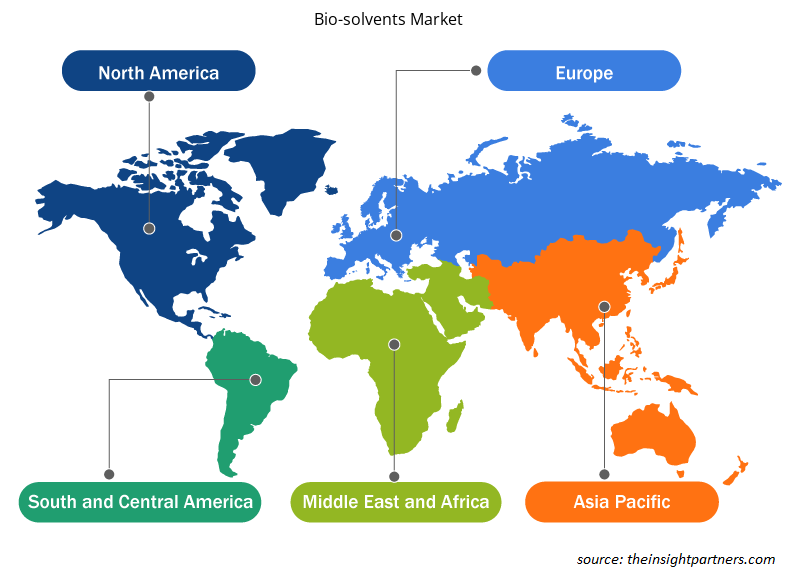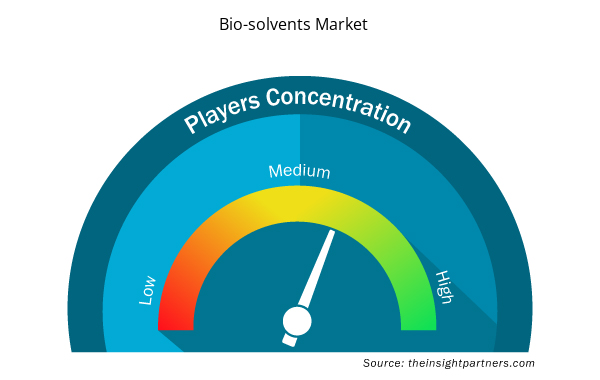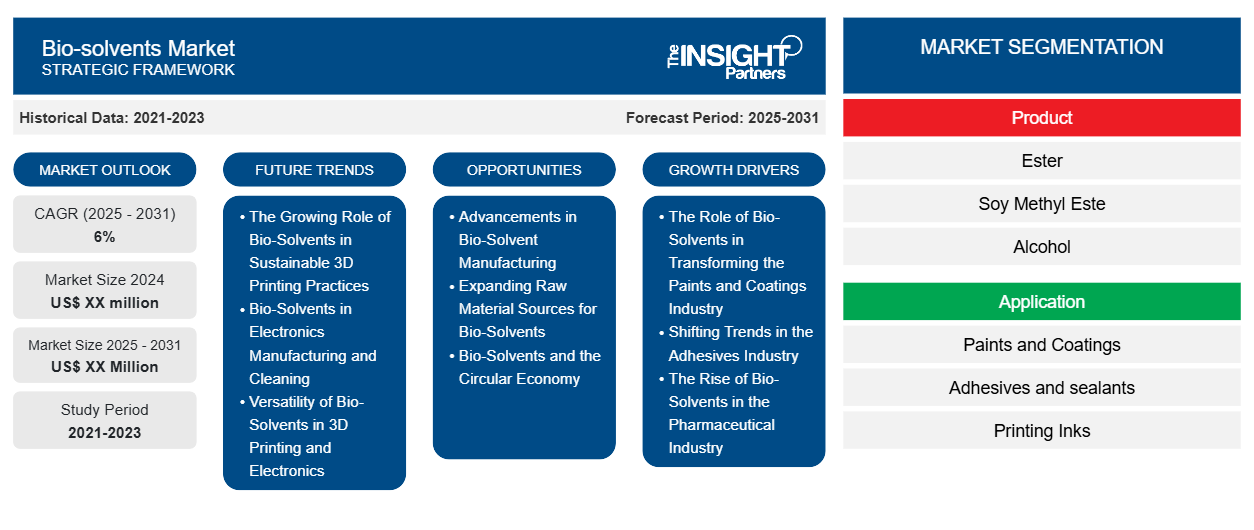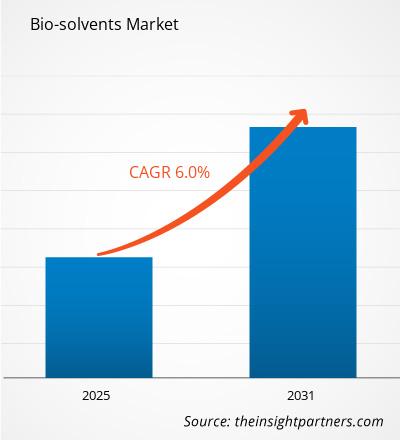Der Markt für Biolösungsmittel wird voraussichtlich von 2024 bis 2031 eine durchschnittliche jährliche Wachstumsrate (CAGR) von 6 % verzeichnen, wobei die Marktgröße von XX Millionen US-Dollar im Jahr 2024 auf XX Millionen US-Dollar im Jahr 2031 wachsen wird.
Der Bericht präsentiert eine produktbasierte Analyse (Ester, Sojamethylester, Alkohol, Glykole und andere). Der Bericht ist nach Anwendung segmentiert (Farben und Beschichtungen, Klebstoffe und Dichtungsmittel, Druckfarben und andere). Die globale Analyse ist weiter auf regionaler Ebene und nach wichtigen Ländern aufgeschlüsselt. Die Marktgröße und -prognose auf globaler, regionaler und Länderebene für alle wichtigen Marktsegmente werden im Rahmen des Berichts abgedeckt. Der Bericht bietet den Wert in USD für die oben genannte Analyse und die Segmente. Der Bericht bietet wichtige Statistiken zum Marktstatus der wichtigsten Marktteilnehmer und bietet Markttrends und -chancen.
Zweck des Berichts
Der Bericht Bio-Lösungsmittelmarkt von The Insight Partners zielt darauf ab, die aktuelle Situation und das zukünftige Wachstum sowie die wichtigsten treibenden Faktoren, Herausforderungen und Chancen zu beschreiben. Dies wird verschiedenen Geschäftspartnern Einblicke geben, wie zum Beispiel:
- Technologieanbieter/-hersteller: Um die sich entwickelnde Marktdynamik zu verstehen und die potenziellen Wachstumschancen zu kennen, damit sie fundierte strategische Entscheidungen treffen können.
- Investoren: Durchführung einer umfassenden Trendanalyse hinsichtlich der Marktwachstumsrate, der finanziellen Marktprognosen und der Chancen entlang der Wertschöpfungskette.
- Regulierungsbehörden: Zur Regulierung von Richtlinien und Überwachungsaktivitäten auf dem Markt mit dem Ziel, Missbrauch zu minimieren, das Vertrauen der Anleger zu bewahren und die Integrität und Stabilität des Marktes aufrechtzuerhalten.
Bio-Lösungsmittel Marktsegmentierung
Produkt
- Ester
- Sojamethylester
- Alkohol
- Glykole
- Sonstiges
Anwendung
- Farben und Lacke
- Klebstoffe und Dichtstoffe
- Druckfarben
- Sonstiges
Passen Sie diesen Bericht Ihren Anforderungen an
Sie erhalten kostenlose Anpassungen an jedem Bericht, einschließlich Teilen dieses Berichts oder einer Analyse auf Länderebene, eines Excel-Datenpakets sowie tolle Angebote und Rabatte für Start-ups und Universitäten.
- Holen Sie sich die wichtigsten Markttrends aus diesem Bericht.Dieses KOSTENLOSE Beispiel umfasst eine Datenanalyse von Markttrends bis hin zu Schätzungen und Prognosen.
Wachstumstreiber auf dem Markt für Biolösungsmittel
- Die Rolle von Biolösungsmitteln bei der Transformation der Farben- und Lackindustrie: Einer der Hauptfaktoren, die das Wachstum der Farben- und Lackindustrie vorantreiben, ist die zunehmende Verwendung von Biolösungsmitteln in der Produktion. Die herkömmlichen Lösungsmittel enthalten häufig VOCs, die sowohl für die Anwender als auch für die Umwelt schädlich sind. Andererseits erfüllen die aus natürlichen Quellen hergestellten Biolösungsmittel problemlos die sehr strengen Lösungsmittelvorschriften, ohne dass die Wirksamkeit der Lösungsmittel beeinträchtigt wird.VOCs, which are harmful to users as well as the environment. On the other hand, the bio-solvents produced from natural sources easily comply with the very harsh solvent regulations that are available without compromising on the power of the solvents.
- Veränderte Trends in der Klebstoffindustrie: Auch der Klebstoffsektor verändert sich, da der Bedarf an umweltfreundlichen Lösungen immer deutlicher wird. Darüber hinaus werden in Klebstoffformulierungen immer häufiger Biolösungsmittel verwendet, was die Entwicklung weniger giftiger und umweltfreundlicherer Produkte durch die Hersteller ermöglicht. Dieser Wandel erfolgt nicht nur, weil Verbraucher nach umweltfreundlicheren Alternativen suchen, sondern auch, um Unternehmen dabei zu helfen, ihre Nachhaltigkeitsziele zu verfolgen und Gesetze einzuhalten.
- Der Aufstieg von Biolösungsmitteln in der Pharmaindustrie: Das Wachstum des Biolösungsmittelmarktes ist auch der Pharmaindustrie zuzuschreiben. Die Verwendung solcher Biolösungsmittel in Arzneimittelformulierungen findet als Lösung, Träger oder Hilfsstoff Anwendung und weist sehr geringe Kontaminationswerte auf. Das wachsende Interesse an der ökologischen Nachhaltigkeit bei der Herstellung von Medikamenten fördert das Wachstum von Biolösungsmitteln und verbessert die Geschäftsaussichten.
Markttrends für Biolösungsmittel
- Die wachsende Rolle von Biolösungsmitteln in nachhaltigen 3D-Druckverfahren: Darüber hinaus ist die Einführung von Biolösungsmitteln in aufstrebenden Branchen wie dem 3D-Druck ein gutes Zeichen für zukünftige Trends auf dem Biolösungsmittelmarkt. Mit der Weiterentwicklung der 3D-Drucktechnologie steigt der Bedarf an nachhaltigen Materialien. Biolösungsmittel werden zum Reinigen und Auflösen von Substanzen verwendet und tragen daher zur Transformation der Branche bei, die umweltfreundlicher wird.
- Biolösungsmittel in der Elektronikfertigung und -reinigung: Der Markt für Biolösungsmittel bietet auch Chancen durch die zunehmende Anwendung von Biolösungsmitteln bei der Reinigung und Herstellung elektronischer Geräte. Herkömmliche Lösungsmittel sind stark umweltschädlich und schädlich für die menschliche Gesundheit. Daher ist die Verwendung von Biolösungsmitteln eine praktikable Alternative. Ihre Wirksamkeit im Betrieb bei gleichzeitiger Verringerung des Toxizitätsgrads hilft Herstellern dabei, umweltfreundliche Richtlinien einzuhalten, was die Marktexpansion fördert.
- Vielseitigkeit von Biolösungsmitteln im 3D-Druck und in der Elektronik: Darüber hinaus ermöglicht die integrierte Struktur von Biolösungsmitteln deren Verwendung in einer Reihe von 3D-Druck- und Elektronikformulierungen. Biolösungsmittel können von Tinten bis hin zu Beschichtungen verwendet werden und erfüllen dennoch Umweltauflagen, ohne dass die Produkteffizienz verloren geht. Eine derart breite Anwendung von Biolösungsmitteln macht sie zum Kern jedes kreativen Produktionsprozesses.
Marktchancen für Biolösungsmittel
- Fortschritte bei der Herstellung von Biolösungsmitteln: Die Verbesserung bestehender Herstellungsverfahren für Biolösungsmittel führt zu einer schnelleren und besser skalierbaren Produktion von Biolösungsmitteln. Neue Extraktions- und Fermentationstechniken ermöglichen es den Herstellern, die mit der Herstellung von Biolösungsmitteln verbundenen Kosten zu senken. Diese Verbesserungen senken nicht nur die Produktionskosten, sondern verbessern auch die Qualität und Wirksamkeit der Endprodukte und fördern so die weitere Verwendung in zahlreichen Bereichen.
- Erweiterung der Rohstoffquellen für Biolösungsmittel: Weitere Expansionsmöglichkeiten ergeben sich durch die neue Nachfrage nach Biolösungsmitteln aus verschiedenen biologischen Rohstoffen. Die Verwendung von Materialien wie landwirtschaftlichen Abfällen und Nicht-Lebensmittelpflanzen sorgt für eine diversifizierte Rohstoffbeschaffung. Diese Rohstoffe sorgen für einen geringeren Verbrauch von Rohölquellen, was eine globale Agenda ist und die Verwendung von Biolösungsmitteln begünstigt.
- Biolösungsmittel und Kreislaufwirtschaft: Derselbe Ansatz gilt auch für den Übergang zur Kreislaufwirtschaft. Durch die Verwendung erneuerbarer Ressourcen und die Reduzierung von Abfällen können Hersteller von Biolösungsmitteln ein umweltfreundliches Image aufbauen und vermitteln. Eine solche Idee wird von Verbrauchern und Unternehmen angenommen und schafft eine Nachfrage nach Produkten mit diesen Eigenschaften.
Regionale Einblicke in den Markt für Biolösungsmittel
Die regionalen Trends und Faktoren, die den Markt für Biolösungsmittel im Prognosezeitraum beeinflussen, wurden von den Analysten von Insight Partners ausführlich erläutert. In diesem Abschnitt werden auch die Marktsegmente und die Geografie für Biolösungsmittel in Nordamerika, Europa, im asiatisch-pazifischen Raum, im Nahen Osten und Afrika sowie in Süd- und Mittelamerika erörtert.

- Erhalten Sie regionale Daten zum Biolösungsmittelmarkt
Umfang des Marktberichts zu Biolösungsmitteln
| Berichtsattribut | Details |
|---|---|
| Marktgröße im Jahr 2024 | XX Millionen US-Dollar |
| Marktgröße bis 2031 | XX Millionen US-Dollar |
| Globale CAGR (2025 - 2031) | 6 % |
| Historische Daten | 2021-2023 |
| Prognosezeitraum | 2025–2031 |
| Abgedeckte Segmente | Nach Produkt
|
| Abgedeckte Regionen und Länder | Nordamerika
|
| Marktführer und wichtige Unternehmensprofile |
|
Dichte der Marktteilnehmer für Biolösungsmittel: Auswirkungen auf die Geschäftsdynamik verstehen
Der Markt für Biolösungsmittel wächst rasant, angetrieben durch die steigende Nachfrage der Endverbraucher aufgrund von Faktoren wie sich entwickelnden Verbraucherpräferenzen, technologischen Fortschritten und einem größeren Bewusstsein für die Vorteile des Produkts. Mit steigender Nachfrage erweitern Unternehmen ihr Angebot, entwickeln Innovationen, um die Bedürfnisse der Verbraucher zu erfüllen, und nutzen neue Trends, was das Marktwachstum weiter ankurbelt.
Die Marktteilnehmerdichte bezieht sich auf die Verteilung der Firmen oder Unternehmen, die in einem bestimmten Markt oder einer bestimmten Branche tätig sind. Sie gibt an, wie viele Wettbewerber (Marktteilnehmer) in einem bestimmten Marktraum im Verhältnis zu seiner Größe oder seinem gesamten Marktwert präsent sind.
Die wichtigsten auf dem Markt für Biolösungsmittel tätigen Unternehmen sind:
- Archer Daniels Midland Company
- BASF SE
- BioAmber Inc.
- Cargill, Incorporated.
- Corbion
Haftungsausschluss : Die oben aufgeführten Unternehmen sind nicht in einer bestimmten Reihenfolge aufgeführt.

- Überblick über die wichtigsten Akteure auf dem Markt für Biolösungsmittel
Wichtige Verkaufsargumente
- Umfassende Abdeckung: Der Bericht deckt die Analyse von Produkten, Dienstleistungen, Typen und Endbenutzern des Biolösungsmittelmarktes umfassend ab und bietet einen ganzheitlichen Überblick.
- Expertenanalyse: Der Bericht basiert auf dem umfassenden Verständnis von Branchenexperten und Analysten.
- Aktuelle Informationen: Der Bericht stellt durch die Abdeckung aktueller Informationen und Datentrends Geschäftsrelevanz sicher.
- Anpassungsoptionen: Dieser Bericht kann angepasst werden, um spezifische Kundenanforderungen zu erfüllen und die Geschäftsstrategien optimal anzupassen.
Der Forschungsbericht zum Markt für Biolösungsmittel kann daher dabei helfen, die Branchensituation und Wachstumsaussichten zu entschlüsseln und zu verstehen. Obwohl es einige berechtigte Bedenken geben kann, überwiegen die allgemeinen Vorteile dieses Berichts tendenziell die Nachteile.
- Historische Analyse (2 Jahre), Basisjahr, Prognose (7 Jahre) mit CAGR
- PEST- und SWOT-Analyse
- Marktgröße Wert/Volumen – Global, Regional, Land
- Branche und Wettbewerbsumfeld
- Excel-Datensatz



Report Coverage
Revenue forecast, Company Analysis, Industry landscape, Growth factors, and Trends

Segment Covered
This text is related
to segments covered.

Regional Scope
North America, Europe, Asia Pacific, Middle East & Africa, South & Central America

Country Scope
This text is related
to country scope.
Häufig gestellte Fragen
The adoption of bio-solvents in emerging industries like 3D printing is expected to be the key market trends.
Based on product, the ester segment is expected to witness the fastest growth during the forecast period
Based on geography, North America held the largest share of the bio-solvents market due to stringent environmental regulations and a strong emphasis on sustainability.
The increasing use of bio-solvents in paints and coatings is driving the market growth.
BASF SE; Dow Chemical Company; Huntsman Corp; E.I. du Pont de Nemours and Co; Cargill Inc; LyondellBasell; BioAmber; Myriant Corp; Vertec Biosolvents; and Stepan Company are some of the key players operating in the bio-solvents market
The Bio-solvents Market is estimated to witness a CAGR of 6% from 2023 to 2031
Trends and growth analysis reports related to Chemicals and Materials : READ MORE..
1. Archer Daniels Midland Company
2. BASF SE
3. BioAmber Inc.
4. Cargill, Incorporated.
5. Corbion
6. Dow Chemical Company
7. Florida Chemicals
8. Huntsman International LLC.
9. Shenzhen Esuns Industrial Co., Ltd
10. Stepan Company
The Insight Partners performs research in 4 major stages: Data Collection & Secondary Research, Primary Research, Data Analysis and Data Triangulation & Final Review.
- Data Collection and Secondary Research:
As a market research and consulting firm operating from a decade, we have published and advised several client across the globe. First step for any study will start with an assessment of currently available data and insights from existing reports. Further, historical and current market information is collected from Investor Presentations, Annual Reports, SEC Filings, etc., and other information related to company’s performance and market positioning are gathered from Paid Databases (Factiva, Hoovers, and Reuters) and various other publications available in public domain.
Several associations trade associates, technical forums, institutes, societies and organization are accessed to gain technical as well as market related insights through their publications such as research papers, blogs and press releases related to the studies are referred to get cues about the market. Further, white papers, journals, magazines, and other news articles published in last 3 years are scrutinized and analyzed to understand the current market trends.
- Primary Research:
The primarily interview analysis comprise of data obtained from industry participants interview and answers to survey questions gathered by in-house primary team.
For primary research, interviews are conducted with industry experts/CEOs/Marketing Managers/VPs/Subject Matter Experts from both demand and supply side to get a 360-degree view of the market. The primary team conducts several interviews based on the complexity of the markets to understand the various market trends and dynamics which makes research more credible and precise.
A typical research interview fulfils the following functions:
- Provides first-hand information on the market size, market trends, growth trends, competitive landscape, and outlook
- Validates and strengthens in-house secondary research findings
- Develops the analysis team’s expertise and market understanding
Primary research involves email interactions and telephone interviews for each market, category, segment, and sub-segment across geographies. The participants who typically take part in such a process include, but are not limited to:
- Industry participants: VPs, business development managers, market intelligence managers and national sales managers
- Outside experts: Valuation experts, research analysts and key opinion leaders specializing in the electronics and semiconductor industry.
Below is the breakup of our primary respondents by company, designation, and region:

Once we receive the confirmation from primary research sources or primary respondents, we finalize the base year market estimation and forecast the data as per the macroeconomic and microeconomic factors assessed during data collection.
- Data Analysis:
Once data is validated through both secondary as well as primary respondents, we finalize the market estimations by hypothesis formulation and factor analysis at regional and country level.
- Macro-Economic Factor Analysis:
We analyse macroeconomic indicators such the gross domestic product (GDP), increase in the demand for goods and services across industries, technological advancement, regional economic growth, governmental policies, the influence of COVID-19, PEST analysis, and other aspects. This analysis aids in setting benchmarks for various nations/regions and approximating market splits. Additionally, the general trend of the aforementioned components aid in determining the market's development possibilities.
- Country Level Data:
Various factors that are especially aligned to the country are taken into account to determine the market size for a certain area and country, including the presence of vendors, such as headquarters and offices, the country's GDP, demand patterns, and industry growth. To comprehend the market dynamics for the nation, a number of growth variables, inhibitors, application areas, and current market trends are researched. The aforementioned elements aid in determining the country's overall market's growth potential.
- Company Profile:
The “Table of Contents” is formulated by listing and analyzing more than 25 - 30 companies operating in the market ecosystem across geographies. However, we profile only 10 companies as a standard practice in our syndicate reports. These 10 companies comprise leading, emerging, and regional players. Nonetheless, our analysis is not restricted to the 10 listed companies, we also analyze other companies present in the market to develop a holistic view and understand the prevailing trends. The “Company Profiles” section in the report covers key facts, business description, products & services, financial information, SWOT analysis, and key developments. The financial information presented is extracted from the annual reports and official documents of the publicly listed companies. Upon collecting the information for the sections of respective companies, we verify them via various primary sources and then compile the data in respective company profiles. The company level information helps us in deriving the base number as well as in forecasting the market size.
- Developing Base Number:
Aggregation of sales statistics (2020-2022) and macro-economic factor, and other secondary and primary research insights are utilized to arrive at base number and related market shares for 2022. The data gaps are identified in this step and relevant market data is analyzed, collected from paid primary interviews or databases. On finalizing the base year market size, forecasts are developed on the basis of macro-economic, industry and market growth factors and company level analysis.
- Data Triangulation and Final Review:
The market findings and base year market size calculations are validated from supply as well as demand side. Demand side validations are based on macro-economic factor analysis and benchmarks for respective regions and countries. In case of supply side validations, revenues of major companies are estimated (in case not available) based on industry benchmark, approximate number of employees, product portfolio, and primary interviews revenues are gathered. Further revenue from target product/service segment is assessed to avoid overshooting of market statistics. In case of heavy deviations between supply and demand side values, all thes steps are repeated to achieve synchronization.
We follow an iterative model, wherein we share our research findings with Subject Matter Experts (SME’s) and Key Opinion Leaders (KOLs) until consensus view of the market is not formulated – this model negates any drastic deviation in the opinions of experts. Only validated and universally acceptable research findings are quoted in our reports.
We have important check points that we use to validate our research findings – which we call – data triangulation, where we validate the information, we generate from secondary sources with primary interviews and then we re-validate with our internal data bases and Subject matter experts. This comprehensive model enables us to deliver high quality, reliable data in shortest possible time.


 Holen Sie sich ein kostenloses Muster für diesen Bericht
Holen Sie sich ein kostenloses Muster für diesen Bericht